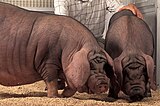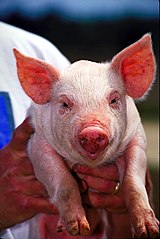Пасмина — разлика између измена
. |
(нема разлике)
|
Верзија на датум 11. фебруар 2022. у 15:59
Један корисник управо ради на овом чланку. Молимо остале кориснике да му допусте да заврши са радом. Ако имате коментаре и питања у вези са чланком, користите страницу за разговор.
Хвала на стрпљењу. Када радови буду завршени, овај шаблон ће бити уклоњен. Напомене
|

A breed is a specific group of domestic animals having homogeneous appearance (phenotype), homogeneous behavior, and/or other characteristics that distinguish it from other organisms of the same species. In literature, there exist several slightly deviating definitions.[2][3] Breeds are formed through genetic isolation and either natural adaptation to the environment or selective breeding, or a combination of the two. Despite the centrality of the idea of "breeds" to animal husbandry and agriculture, no single, scientifically accepted definition of the term exists.[4]:340 It was shown by set-theoretic means that for the term breed an infinite number of different definitions, which more or less meet the common requirements found in literature, can be given.[3] A breed is therefore not an objective or biologically verifiable classification but is instead a term of art amongst groups of breeders who share a consensus around what qualities make some members of a given species members of a nameable subset.[5]
Another point of view is that a breed is consistent enough in type to be logically grouped together and when mated within the group produce the same type.[6] When bred together, individuals of the same breed pass on these predictable traits to their offspring, and this ability – known as "breeding true" – is a requirement for a breed. Plant breeds are more commonly known as cultivars. The offspring produced as a result of breeding animals of one breed with other animals of another breed are known as crossbreeds or mixed breeds. Crosses between animal or plant variants above the level of breed/cultivar (i.e. between species, subspecies, botanical variety, even different genera) are referred to as hybrids.[7]

In biological taxonomy, race is an informal rank in the taxonomic hierarchy for which various definitions exist. Sometimes it is used to denote a level below that of subspecies, while at other times it is used as a synonym for subspecies.[8] It has been used as a higher rank than strain, with several strains making up one race.[9][10] Races may be genetically distinct populations of individuals within the same species,[11] or they may be defined in other ways, e.g. geographically, or physiologically.[12] Genetic isolation between races is not complete, but genetic differences may have accumulated that are not (yet) sufficient to separate species.[13]
The term is recognized by some, but not governed by any of the formal codes of biological nomenclature. Taxonomic units below the level of subspecies are not typically applied to animals.[14]
Оплемењивање: селекција по узгајивачима
The breeder (or group of breeders) who initially establishes a breed does so by selecting individual animals from within a gene pool that they see as having the necessary qualities needed to enhance the breed model they are aiming for. These animals are referred to as foundation stock. Furthermore, the breeder mates the most desirable representatives of the breed from his or her point of view, aiming to pass such characteristics to their progeny. This process is known as selective breeding. A written description of desirable and undesirable breed representatives is referred to as a breed standard.
Карактеристике расе
Breed specific characteristics, also known as breed traits, are inherited, and purebred animals pass such traits from generation to generation. Thus, all specimens of the same breed carry several genetic characteristics of the original foundation animal(s). In order to maintain the breed, a breeder would select those animals with the most desirable traits to achieve further maintenance and developing of such traits. At the same time, the breed would avoid animals carrying characteristics undesirable or not typical for the breed, including faults or genetic defects. The population within the same breed should consist of a sufficient number of animals to maintain the breed within the specified parameters without the necessity of forced inbreeding.
Domestic animal breeds commonly differ from country to country, and from nation to nation. Breeds originating in a certain country are known as "native breeds" of that country.
Референце
- ^ The Cattle Site: Breeds Brown Swiss Retrieved 22 February 2021
- ^ S. J. G. Hall, D. G. Bradley (1995), „Conserving livestock breed biodiversity”, TREE, 10 (7), стр. 267—70, PMID 21237034, doi:10.1016/0169-5347(95)90005-5
- ^ а б G. Langer (2018), „Possible mathematical definitions of the biological term "breed"”, Archives Animal Breeding, 61 (2), стр. 229—243, doi:10.5194/aab-61-229-2018

- ^ Barbara Rischkowsky, Dafydd Pilling (editors) (2007). The State of the World's Animal Genetic Resources for Food and Agriculture. Rome: Commission on Genetic Resources for Food and Agriculture, Food and Agriculture Organization of the United Nations. ISBN 9789251057629. Archived 10 January 2017.
- ^ Jay Laurence Lush, A. B. Chapman (1994). The Genetics of Populations. Ames, Iowa: Iowa Agriculture and Home Economics Experiment Station, College of Agriculture, Iowa State University. Cited in: Barbara Rischkowsky, Dafydd Pilling (editors) (2007). The State of the World's Animal Genetic Resources for Food and Agriculture. Rome: Commission on Genetic Resources for Food and Agriculture, Food and Agriculture Organization of the United Nations. ISBN 9789251057629, page 340.
- ^ Clutton-Brock, Juliet. 1987 A Natural History of Domesticated Mammals, Cambridge University Press and the Museum of Natural History, page 40.
- ^ Banga, Surinder S. (November 25, 1998). Hybrid Cultivar Development, p. 119. Springer-Verlag. ISBN 3-540-63523-8
- ^ Keita, S O Y; Kittles, R A; Royal, C D M; Bonney, G E; Furbert-Harris, P; Dunston, G M; Rotimi, C N (2004). „Conceptualizing human variation”. Nature Genetics. 36 (11s): S17—S20. PMID 15507998. doi:10.1038/ng1455
 . „Modern human biological variation is not structured into phylogenetic subspecies ('races'), nor are the taxa of the standard anthropological 'racial' classifications breeding populations.”
. „Modern human biological variation is not structured into phylogenetic subspecies ('races'), nor are the taxa of the standard anthropological 'racial' classifications breeding populations.”
- ^ Gotoh, T.; Bruin, J.; Sabelis, M. W.; Menken, S. B. J. (1993). „Host race formation in Tetranychus urticae: Genetic differentiation, host plant preference, and mate choice in a tomato and a cucumber strain”. Entomologia Experimentalis et Applicata (Submitted manuscript). 68 (2): 171—178. S2CID 86180826. doi:10.1111/j.1570-7458.1993.tb01700.x.
- ^ Ritchie, D. F.; Dittapongpitch, V. (1991), „Copper- and Streptomycin-resistant Strains and Host Differentiated Races of Xanthomonas campestris pv. vesicatoria in North Carolina” (PDF), Plant Disease, 75 (7): 733—736, doi:10.1094/pd-75-0733
- ^ Walker, Peter M. B., ур. (2004) [1999]. „Race”. Chambers Dictionary of Science and Technology. Edinburgh / New Delhi: Chambers Harrap / Allied Chambers. Republished without known revision several times since 1999, and originally published as: The Wordsworth Dictionary of Science and Technology. W. R. Chambers Ltd. and Cambridge University Press. 1988.
- ^ Morris, Christopher, ур. (1992). „Race”. Academic Press Dictionary of Science and Technology
 . San Diego / London: Academic Press (Harcourt Brace Jovanovich). "Biology" entry, p. 1777. ISBN 978-0-12-200400-1. „an interbreeding subgroup of a species whose individuals are geographically, physiologically, or chromosomally distinct from other members of the species”
. San Diego / London: Academic Press (Harcourt Brace Jovanovich). "Biology" entry, p. 1777. ISBN 978-0-12-200400-1. „an interbreeding subgroup of a species whose individuals are geographically, physiologically, or chromosomally distinct from other members of the species”
- ^ Jaenike, J. (1981), „Criteria for Ascertaining the Existence of Host Races”, The American Naturalist, 117 (5): 830—834, JSTOR 2460772, S2CID 84136840, doi:10.1086/283771
- ^ Haig, S.M.; Beever, E.A.; Chambers, S.M.; Draheim, H.M.; Dugger, B.D. (децембар 2006). „Taxonomic considerations in listing subspecies under the U.S. Endangered Species Act”. Conservation Biology. 20 (6): 1584—1594. PMID 17181793. doi:10.1111/j.1523-1739.2006.00530.x.
Литература
- FAO. 2007. The Global Plan of Action for Animal Genetic Resources and the Interlaken Declaration. Rome.
- FAO. 2012. Phenotypic characterization of animal genetic resources. FAO Animal Production and Health Guidelines No. 11. Rome.
- FAO. 2015. The Second Report on the State of the World's Animal Genetic Resources for Food and Agriculture. Rome.
- Lush, JL (1937), Animal Breeding Plans, Ames, Iowa: Iowa State Press
- Kempthorne, O (1957), Introduction to Statistic Genetics, John Wiley & Sons
- Van Vleck; L. D.; Searle; S. R. (1979), Variance components and animal breeding: proceedings of a conference in honor of C.R. Henderson, Ithaca, N.Y.: Cornell University
- Henderson, CR (1984), Applications of linear models in animal breeding, Guelph, Ont: University of Guelph, ISBN 0-88955-030-1
- Hammond K. Gianola, D. (1990), Advances in Statistical Methods for Genetic Improvement of Livestock (Advanced Series in Agricultural Sciences), Springer-Verlag Berlin and Heidelberg GmbH & Co. K, ISBN 3-540-50809-0
- Massey, JW; Vogt, DW (1993), Heritability and Its Use in Animal Breeding, Department of Animal Sciences, University of Missouri
- Mrode, R. A. (1996), Linear models for the prediction of animal breeding values, Oxon: CAB International, ISBN 0-85198-996-9
- Cameron, N. D. (1997), Selection indices and prediction of genetic merit in animal breeding, Oxon: CAB International, ISBN 0-85199-169-6
- Dalton, C; Willis, MB (1998), Dalton's Introduction to Practical Animal Breeding, Oxford: Blackwell Science, ISBN 0-632-04947-2
- Bourdon, RM (2000), Understanding animal breeding, Englewood Cliffs, N.J: Prentice Hall, ISBN 0-13-096449-2
- Newman, S; Rothschild, MF (2002), Intellectual Property Rights in Animal Breeding and Genetics, Wallingford, Oxon, UK: CABI Pub, ISBN 0-85199-641-8
- FAO. (2007). The Global Plan of Action for Animal Genetic Resources and the Interlaken Declaration. Rome.
- FAO. (2010). Breeding strategies for sustainable management of animal genetic resources. FAO Animal Production and Health Guidelines. No. 3. Rome.
- FAO. (2015). The Second Report on the State of the World's Animal Genetic Resources for Food and Agriculture. Rome.
- Oklahoma Cooperative Extension Service, Division of Agricultural Sciences and Natural Resources (n.d). „Selection of Swine Breeding Stock” (PDF). стр. 1—4. Архивирано из оригинала (PDF) 2011-09-29. г. Приступљено 2011-09-01.
- James Warren Evans (1992). Horse breeding and management. Elsevier Health Science. ISBN 978-0-444-88282-0.
Спољашње везе
- Commission on Genetic Resources for Food and Agriculture - Food and Agriculture Organization of the United Nations
- Breeds of Livestock - Oklahoma State University
- Animal Breeding - The Genetic Basis Of Animal Breeding, Economic Considerations, Modern Methods In Biotechnology, Artificial Insemination
- Domestic Animal Diversity Information System
- Guidelines For Uniform Swine Improvement Programs, National Swine Improvement Federation, 2003, Архивирано из оригинала 2008-10-21. г.
- Implementing the Global Plan of Action for Animal Genetic Resources
- bataille de la somme
- Animal Breeding and Genomics Centre, Wageningen University, Netherlands
- Animal Breeding and Genetics Group, University of Georgia, USA
- Centre for Genetic Improvement of Livestock, University of Guelph, Canada
- Animal Breeding & Genetics, Cornell University, USA
- Animal Breeding & Genetics, Iowa State University, USA
- Breeding and Genetics Program, Colorado State University, USA, Архивирано из оригинала 2008-10-12. г.
- Animal Genetics and Breeding Unit, University of New England, Australia
- European Graduate School in Animal Breeding and Genetics (EGS-ABG), AgroParisTech, France ; Wageningen University, Netherlands ; Aarhus University, Denmark ; Swedish University of Agricultural Sciences, Sweden



